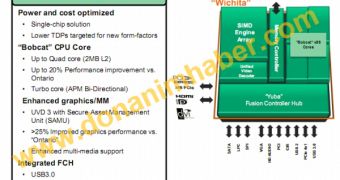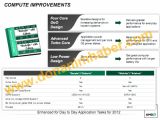Though they will let themselves be waited on for many months to come, the upcoming Deccan platform, particularly the two chips that are part of it, have again fallen under the eye of market watchers.
AMD's existing APUs are guaranteed to stick around for a while yet, but the Sunnyvale, California-based company is well into researching and developing the so-called successors.
In fact, there have been enough words on the Wichita and Krishna, as they are called, that users can already create a vaguely accurate image of what they can do.
The processors are designed in such a way that they come closer to qualifying as full-fledged SoC (system-on-chip) devices than as central processing units.
Still, this does not mean that they lack any features of a CPU. To the contrary, they are what one might call CPUs and more.
In keeping with expectations, up to four Bobcat cores are present, along with 2 MB of L2 cache, the Turbo Core dynamic overclocking technology and a graphics core which, among other things, supports DirectX 11 features.
The manufacturing process at the basis of them all will be the 28nm, the same one that not just AMD, but also NVIDIA feels very confident about.
To these is added the 'Yuba' controller hub (handles the SATA, USB 3.0, USB 2.0, HD audio and other ports and elements).
Furthermore, the UVD3 video decoder will be present among the list of assets, as will be DDR3-1600 and low-voltage RAM (random access memory) support, plus an increase to processing and graphics power of 20% and 25%, respectively.
2012 is the earliest when one can expect and hope to see some sales commencing, although official information on the units should emerge sooner, before this year (2011) is out. C and E-series are the likeliest branding schemes that one can look forward to seeing on the labels.

 14 DAY TRIAL //
14 DAY TRIAL // 
